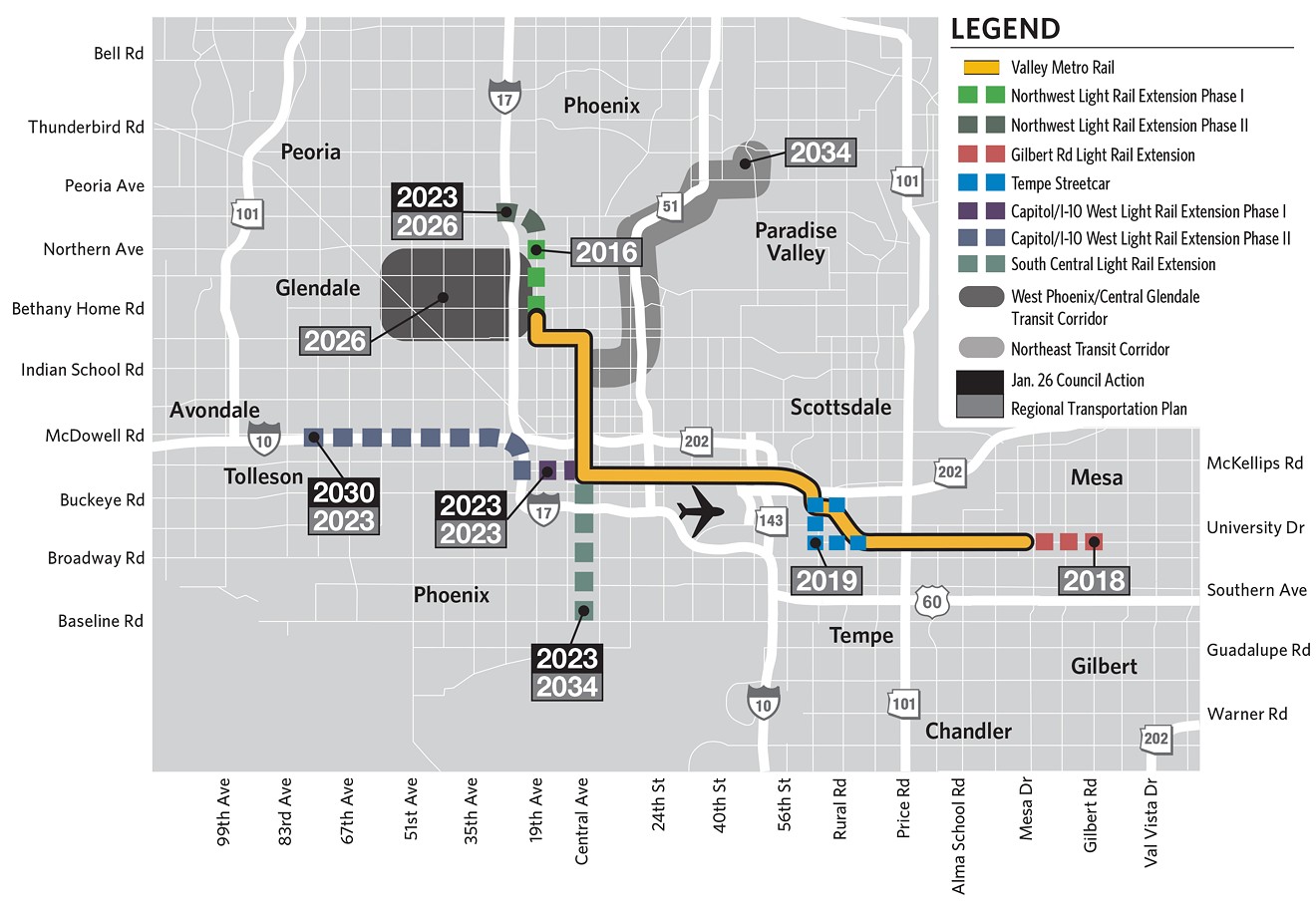Wednesday night, the Phoenix City Council voted to approve a $50-million deal that will fund design and pre-construction costs for Valley Metro’s expansion in South Phoenix. It’s the latest step towards creating a new offshoot of the light rail, which will run south down Central Avenue, starting at Jefferson Street and ending at Baseline Road.
But some residents who attended the meeting raised concerns about whether that means that expensive apartments in high-rise towers will follow, and existing residents of the historically black and Latino area will wind up getting displaced.
“I’m excited about the light rail — I think it’s going to provide a lot more opportunities for residents,” Isabel Garcia, who grew up in South Phoenix and now works as a social worker there, told the City Council. “I’m also concerned about the challenges that it will bring, including forcing people out of their homes and their businesses, and that it may not be equitable — that certain groups will benefit from this more than others.”
It’s hard to find fault with Valley Metro’s choice to expand the light rail down South Central: The surrounding community is home to a lot of low-wage workers who rely on public transit to get around, and have historically been underserved in that regard.
Johnny Hernandez, who described himself as a lifelong resident of South Phoenix, testified that bringing light rail to the neighborhood will “move marginalized people off the margins, and give them access to better jobs.”
“It’s something that we’ve been waiting for for a long time, that will connect us to the rest of the city,” he added. “I’ve had to ride my bike at 11 o’clock at night to [get to] a job at three o’clock in the morning because the bus didn’t run.”
Roughly 28 percent of residents in the area surrounding the proposed light rail corridor don’t own cars, a 2015 report by Arizona Alliance for Livable Communities and Maricopa County Department of Public Health found. By comparison, only 12 percent of all Maricopa County residents are carless.
Those numbers mirror the percentages of people living below the federal poverty level: 29 percent in South Phoenix, compared to 13 percent countywide.
The report also pointed out that the average household income for the neighborhood is $34,789, nearly half the average for Maricopa County.
It concluded that expanding light rail to South Phoenix would have a positive impact.
“The uncontested negative consequences of today’s auto-centric reliance are especially hard on underserved populations," the report noted "[…] Those with challenging health conditions and restricted means, including limited income and disabilities that hinder mobility, are often hit hardest.”
But it’s also easy to imagine that, in time, South Central could end up looking like North Central, with shiny new office towers and apartment buildings on every block. The fact that light rail drives up property values has been well-documented, and as Phoenix's existing light rail line has expanded, new shops and restaurants have followed.
Would that be a bad thing for South Phoenix? Not necessarily. There's plenty of empty space to build on, and many of the residents who testified on Wednesday night agreed that the area needs more development.
They just want to make sure that people who have been living in the neighborhood for years, and, in many cases, have started their own small businesses, benefit from the money flowing into the area.
“The history has been nil to none, as far as inclusiveness to community people who have businesses goes,” Perry Elam from Black Wall Street Arizona said.
Joseph Larios, a South Phoenix native and the co-founder the Center for Neighborhood Leadership, pointed out that the neighborhood’s black and Latino residents had been “stigmatized, criminalized, and precluded from investment.”
“I hope you’re going to recognize that kind of sentiment, which has been placed on this community,” he said.
Ever since the days when so-called “detrimental races and nationalities” — namely Mexican Americans and African Americans — weren’t able to purchase homes north of Van Buren Street, South Phoenix has suffered from disinvestment.
The area has a legacy of industrial contamination as a result of illegal dumping, hazardous waste facilities, and blatant pollution. It’s been burdened with inadequate housing and failing schools, and currently is one of the largest contributors to the state’s prison population.
Now, the fear is that investment in the neighborhood will "push the problems in South Phoenix to other spaces, as opposed to really taking this opportunity to grow the community," neighborhood activist Richard Crews said. “We run the risk of what’s happening in a lot of other cities, with the word that scares a lot of people: displacement.”
Several council members — including Kate Gallego, Daniel Valenzuela, and Michael Nowakowski — were receptive to those concerns and indicated that they wanted to work with existing businesses and community groups.
Vice Mayor Laura Pastor later put out a strongly worded statement, writing, "Too many times in the past have vibrant communities been adversely and irrevocably affected, or even wiped out completely. I pledge this will not happen on my watch once this project moves forward."
Nonetheless, it's completely understandable that community members are skeptical.
As Crews put it, “There’s a long history of things being done to South Phoenix, not with South Phoenix."
[
{
"name": "Air - MediumRectangle - Inline Content - Mobile Display Size",
"component": "18478561",
"insertPoint": "2",
"requiredCountToDisplay": "2"
},{
"name": "Editor Picks",
"component": "16759093",
"insertPoint": "4",
"requiredCountToDisplay": "1"
},{
"name": "Inline Links",
"component": "17980324",
"insertPoint": "8th",
"startingPoint": 8,
"requiredCountToDisplay": "7",
"maxInsertions": 25
},{
"name": "Air - MediumRectangle - Combo - Inline Content",
"component": "16759092",
"insertPoint": "8th",
"startingPoint": 8,
"requiredCountToDisplay": "7",
"maxInsertions": 25
},{
"name": "Inline Links",
"component": "17980324",
"insertPoint": "8th",
"startingPoint": 12,
"requiredCountToDisplay": "11",
"maxInsertions": 24
},{
"name": "Air - Leaderboard Tower - Combo - Inline Content",
"component": "16759094",
"insertPoint": "8th",
"startingPoint": 12,
"requiredCountToDisplay": "11",
"maxInsertions": 24
}
]












